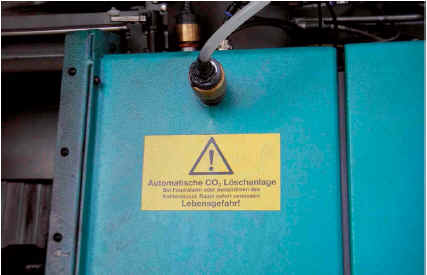Abschnitt 5 - 5 Instructions - Behaviour of workers in case of fire
The employer shall instruct the insured persons (employees) in accordance with the requirements of the German safety at work act and the accident prevention regulation "Grundsätze der Prävention" (Principles of prevention; BGV/GUV-V A1). These instructions inform workers of the hazards resulting from their activities and on the preventive measures. Instruction shall be carried out prior to the beginning of the job and be repeated at regular time intervals but at least once a year.
For activities at machine tools using flammable metalworking fluids, aspects concerning fire and explosion protection should also be addressed within the framework of the training. This includes the general rules of behaviour in case of fire and the general rules of preventive fire protection as e. g. behaviour in case of fire: rescue chain, emergency calls, fire service (compare BGI/GUV-I 560 and clause 3.3.4.6). In addition, the fire and explosion hazards during use of flammable metalworking fluids in machine tools described in detail in the following and suitable protective measures should be explained.
In principle, the instruction includes briefing on the function, operation and handling of installed safety devices, such as e. g. extinguishing systems. In this context, the worker should be informed that optical sensors of extinguishing systems may also respond to light flashes occurring during operation. In order to exclude faulty activation of extinguishing systems, the use of lighters and welding equipment in the vicinity of a machine tool equipped with the aforementioned sensors should be avoided.
If a fire happens in spite of the above-mentioned preventive measures, sudden flame ejections have to be expected especially around the area of machine tool openings (e. g. door gaps or pressure relief valves). This hazard also exists if the machine tool is equipped with an extinguishing system. The abrupt release of extinguishing gases (generally CO2), may intensify flame ejections.
In addition, workers should be informed that the extinguishing gas released - especially in small and badly vented rooms - may cause an asphyxiation hazard besides generating fumes and smoke.

Figure 58 Warning sign for CO2 extinguishing gas hazards
Generally, manual fire fighting should be carried out exclusively by the company fire service or by specially trained persons. It should only be carried out, if hazarda are excluded. It is therefore worthwhile to inform the workers of the special hazards which can occur during the extinguishing of machine fires and the activation of extinguishing measures.
Thus, the hazard of an abrupt outbreak or backfire of unburned MWF when machine doors are opened, cannot be excluded. No oil-soiled or oil-soaked clothing should be worn in order to avoid clothing fires caused by escaping flames. Also fire-resistant textiles can catch fire, if they are wetted with flammable liquids (wicking).
Furthermore, particularly metallic machine parts and surfaces should not be touched after a fire because they may be extremely hot and electrocution hazards caused by charred cables cannot be excluded.
